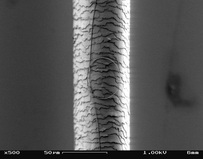Case Study

Levels of trace evidence transfer were examined in a casework context. A girl was allegedly abducted in a car and rape attempted by the accused, who denied any contact with the victim. Clothing worn by the victim and the accused, and the covers from the front seats of the car, were analyzed for trace evidence. Three types of corresponding fibers and four possible pathways of transfer were identified. Synthetic fibers similar to those composing the car seat covers were located on the victim's clothing, consistent with direct transfer. Secondary transfer was indicated by dyed brown human head-type hairs, possibly originating from the accused's wife, located on the seat covers and on the victim's clothing. Secondary and possibly tertiary transfer was indicated by pink synthetic material and associated fibers, possibly originating from the victim's mother, located on the victim's clothing, a car seat cover and the accused's clothing. Light microscopy, comparison microscopy, and cross-sectioning techniques were used. The multiple fiber matches and the differing pathways and levels of transfer increased the strength of the association between the accused and the victim. After the fiber evidence was led at the trial, the accused pleaded guilty, thereby affirming the value of secondary transfer evidence.
